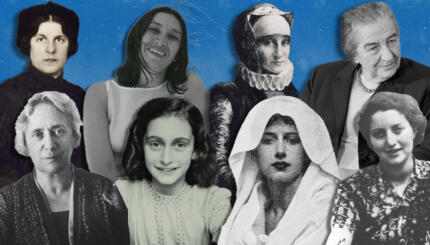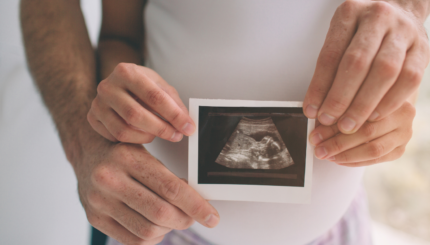Excerpted with permission from A Time for Every Purpose Under Heaven (Farrar, Straus and Giroux, LLC).
Phyllis recalls: As the moon hovered on the edge of , 36–a magical number–of my women friends assembled to celebrate not only the Festival of Light, not only my 50th birthday, but also my menopause. Thirty-six women joined together to end an age-old silence. We had gathered not only to speak about menopause but also to celebrate it. Just as my journey beyond menstruation was still unknown to me, so this ceremony I had just created was a journey still unknown to them.
Ending the Silence About Our Inner Selves
Why did I think it was so important to end the silence about menopause? Three months before my 13th birthday, I "got the curse" and "became a woman," to use two common euphemisms about menstruation. My mother whispered the news to her friend Selma and to Mrs. Goldstein who lived next door, and it was thus that I learned about "women’s things"–and about whispering. In my seventh-grade classrooms, other girls/women were, like me, embarrassed to talk about the changes that had, or had not yet, happened to them. Nothing could have been more on our minds and less on our lips.
Silence is profound. When we cannot speak about what is happening in our bodies, in our hearts, and in our souls, we draw some reasonable but damaging conclusions. We learn that what is public is limited to the world of our minds and, more likely, to the most superficial layers of our minds. We then begin making the distinction between the inner, consuming conversations we have alone or with an intimate few, and the outer disconnected ones we have with others. The disconnections are not only from others but also from ourselves: We lose the at-one-ment we could feel when we perceive ourselves whole and holy in relation to others.

Help us keep Jewish knowledge accessible to millions of people around the world.
Your donation to My Jewish Learning fuels endless journeys of Jewish discovery. With your help, My Jewish Learning can continue to provide nonstop opportunities for learning, connection and growth.
For much of my adult life, I have wanted to speak about the unspeakable. I have longed to move the body and the emotions and the spirit out of the shadows, where they appear hidden, trivial, shameful, even dirty, into the sunlight, where they are real, important, central, and acceptable. For me, the process of making an inner experience public helps me to see my experience as normal, to speak my experience with passion and sureness, and to feel myself integrated within and without.
A Menopause Seder
In my 49th year, as I began to experience the ending of my menstruations, I decided to break through the silence hovering over this passage, with two circles of friends: women, ranging in age from 21 to 58, gathered from all over the country and from various parts of my life, and the women and men of the P’nai Or Havura and other members of the extraordinary Jewish Renewal neighborhood of Mount Airy in Philadelphia.
For the Mount Airy crowd, we held a morning service and a Saturday night Hanukkah-and-birthday party. But in the late afternoon of Shabbat, which was on the winter solstice weekend and just before Hanukkah began, I gathered with my women friends to celebrate my menopause.
To these women I had proposed that we celebrate a " of womanhood"–the order of the stages of womanhood as I had experienced them in my life. As with the traditional Passover seder and the increasingly familiar seder, we drank four cups of beverage as we told our individual stories. We are taught in Pirkei [Ethics of the Fathers] that 50 is the age of advice-giving; but in keeping with modern feminist practice, rather than giving advice, we shared lessons we had learned from each stage of our woman-life.
For the first cup, I served a bright red sangria. (Cherry-apple cider was served to non-alcohol drinkers.) Sangria, the "drink" of my adolescence, represented my first stage of womanhood, menstruation. The group shared stories, some funny and some sad, about first periods and the silence around them; about later periods and their weightiness in our lives–hoping for them when we feared we might be pregnant, fearing them when we prayed we might be pregnant. We recognized ourselves again and again in each other’s stories. Then we drank the first cup.
As we moved on, I suggested a guideline for the remaining three cups: Since everyone in the room had already reached the stage of menstruation, we had all been able to speak from our own experiences. For each of the following cups, women could speak only if they had already reached the stage of life represented by that cup.
The second cup, a sparkling champagne (sparkling apple cider for non-alcohol drinkers), was for my second stage of woman-life–the bubbly, heady introduction to sex and love. Again, we spoke about the silences that had heralded this stage of life: how little we had known about our own bodies, about our own pleasures, about the wide range of potential loving partners (women as well as men). This was not the bawdy, bragging talk of the locker room but rather the sad, sweet talk, long overdue, of innocence and ignorance, of surprise and delight.
The third cup, milk (soymilk for non-dairy drinkers), marked my third stage: pregnancy, childbirth, nursing, child-raising. Not surprising, we again spoke of silences–the silence of abortion, of adoption, of not having children, of the sensuality of nursing, of the passionate protection of and connection to our children.
The fourth cup, water (mineral water for purists), represented the totally open possibilities of the fourth stage of woman-life: menopause. Only about eight in the group had reached menopause, and there was a significant difference in our sharing. What I had imagined would be the most silent of the life-stages, and potentially the most depressing, now appeared quite the opposite.
The silence of menopause had already been broken publicly. In spite of our youth-centered culture, several books about menopause had appeared, as well as a Newsweek cover story focused on turning 50. Many of us now felt about reaching 50 what Gloria Steinem felt at 40. "You don’t look 40," someone remarked to her. She quipped, "This is what 40 looks like!" Rather than experiencing an empty nest at the end of our biologically reproductive lives, many of us at my ceremony felt giddy with freedom, with the chance to forge a new path of our choosing, without obligations. We were asking ourselves, some for the first time, "What do we want to do with this new opportunity?"
While the menopause ceremony suffered some of the awkwardness and embarrassment that accompanies a lifetime of silence, it was also filled with laughter, sorrow, relief, and understanding. I hope the silence that has enveloped so many other important life-turnings will, by the strength of our ceremonies and rituals, our books and our conversations, be similarly broken. Ceremonies and rituals today, like those of old, make each life-stage a time for self-revelation, first to ourselves, then to one another, and then to the larger human community–for breaking out of the tyranny and alienation of silence.
At the end of the ceremony, I read a Marge Piercy poem. When at last that lifelong leak of blood comes to an end, she says, "I will secretly dance and pour out a cup of wine on the earth." Now the dance need no longer be secret. Now menopause may become what the title of her poem calls it: "Something to Look Forward To."


